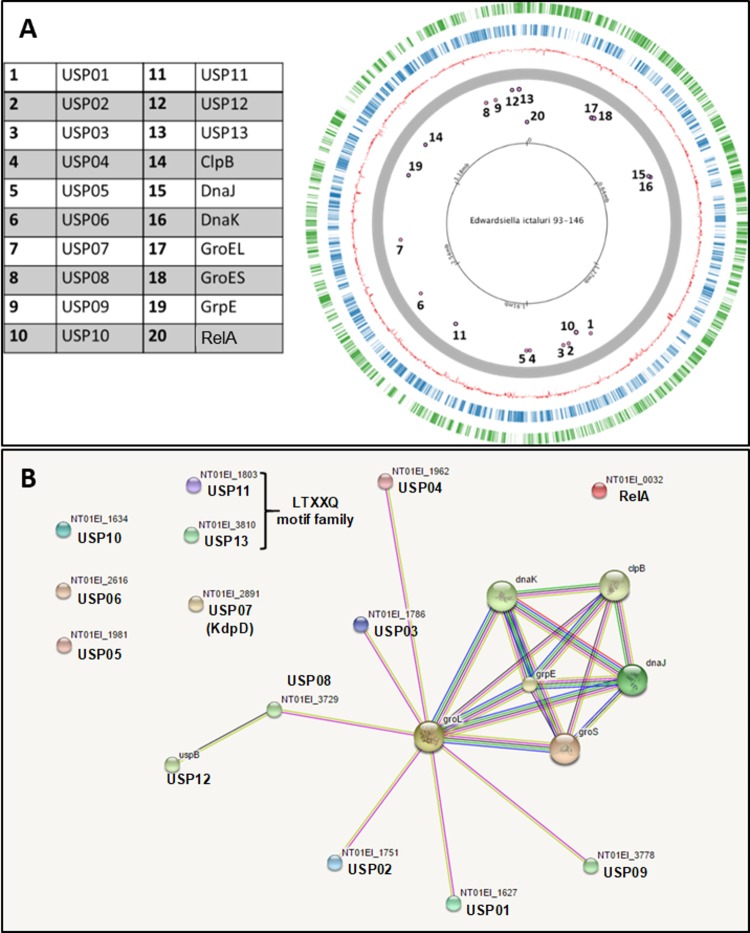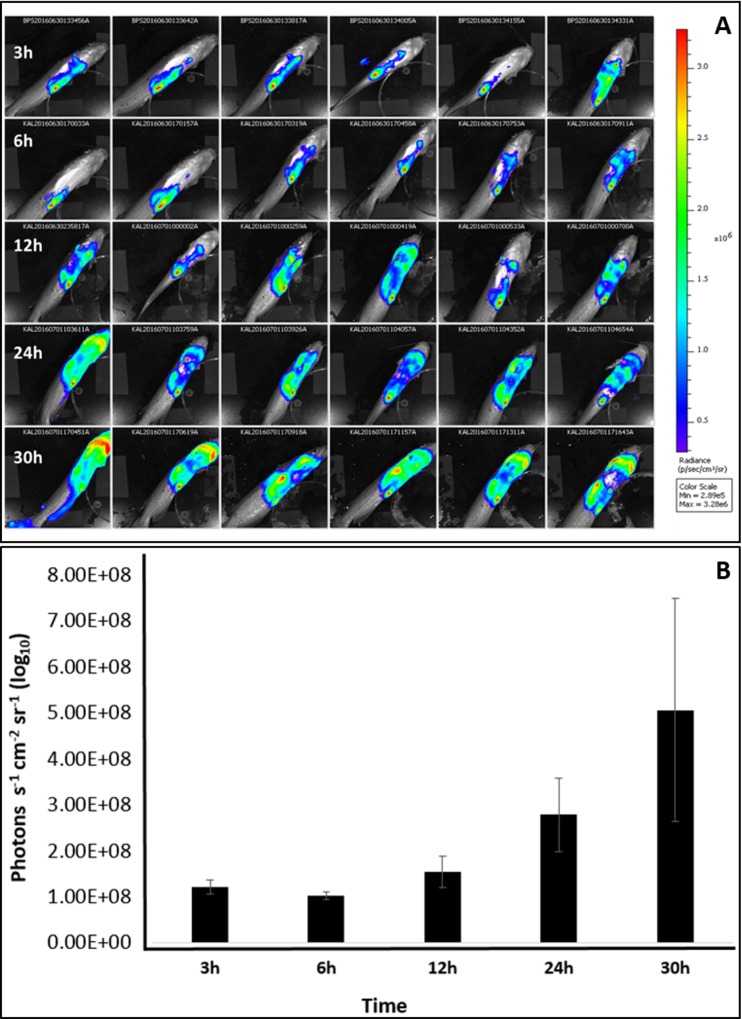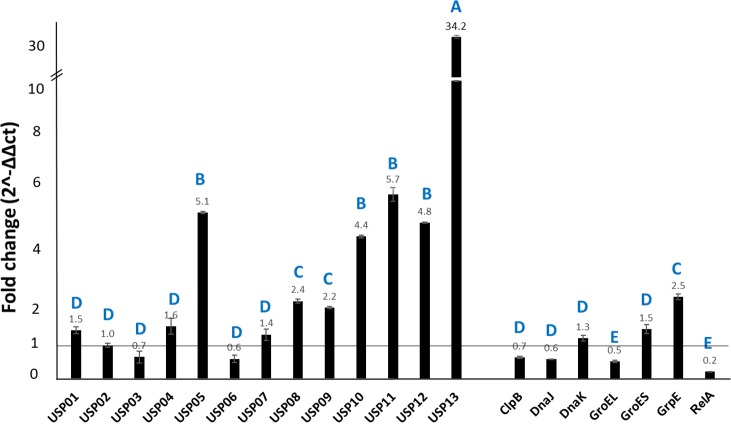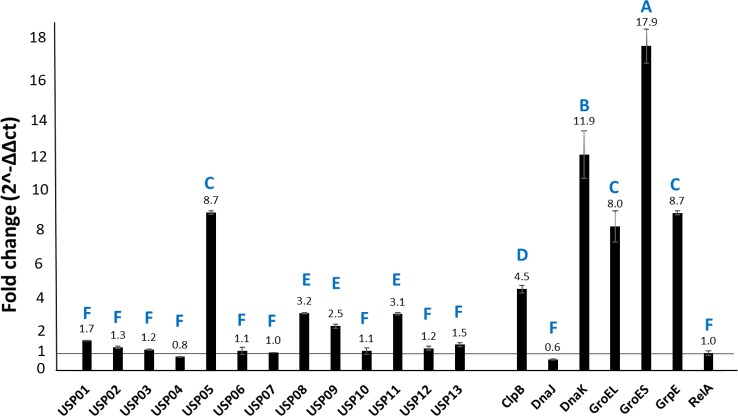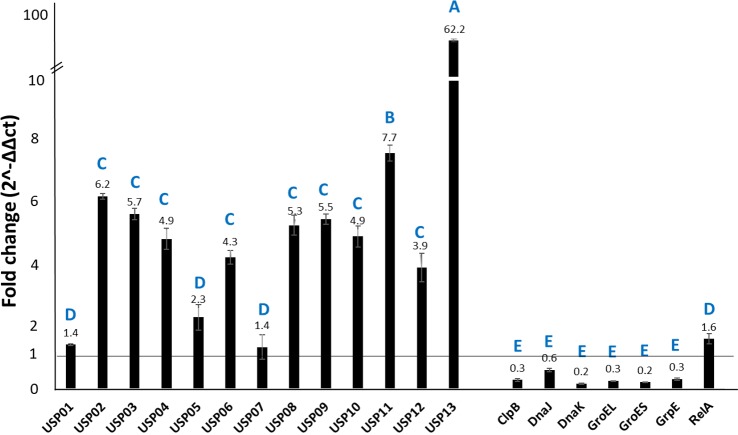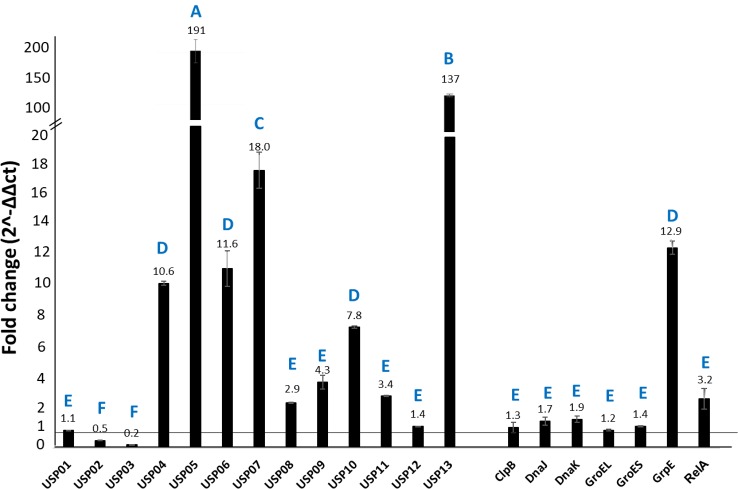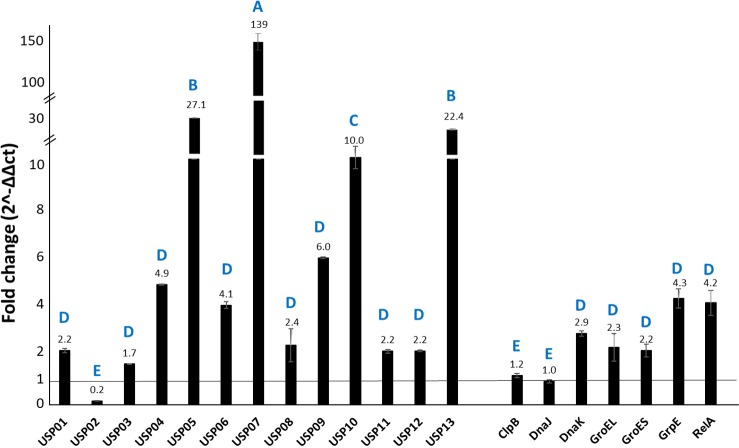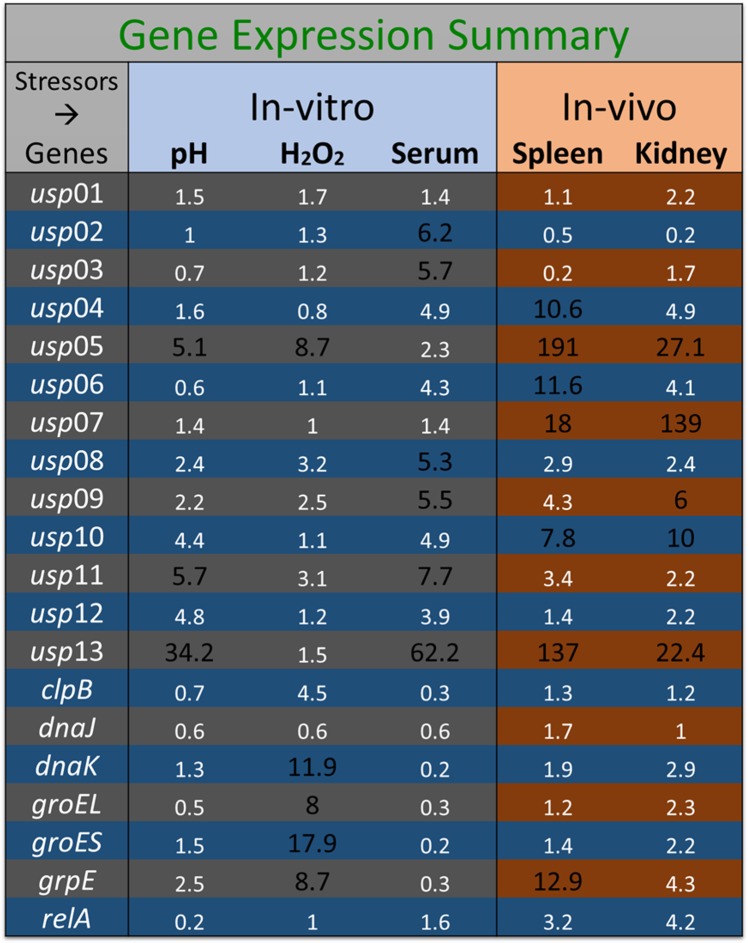Abstract
Edwardsiella ictaluri is a Gram-negative facultative anaerobic rod and the causative agent of enteric septicemia of channel catfish (ESC), which is one of the most prevalent diseases of catfish, causing significant economic losses in the catfish industry. E. ictaluri is resistant to complement system and macrophage killing, which results in rapid systemic septicemia. However, mechanisms of E. ictaluri stress responses under conditions of host environment are not studied well. Therefore, in this work, we report E. ictaluri stress responses during hydrogen peroxide, low pH, and catfish serum stresses as well as during catfish invasion. E. ictaluri stress responses were characterized by identifying expression of 13 universal stress protein (USP) genes (usp01-usp13) and seven USP-interacting protein genes (groEL, groES, dnaK, grpE, and clpB, grpE, relA). Data indicated that three usp genes (usp05, usp07, and usp13) were highly expressed in all stress conditions. Similarly, E. ictaluri heat shock proteins groEL, groES, dnaK, grpE, and clpB were highly expressed in oxidative stress. Also, E. ictaluri grpE and relA were highly expressed in catfish spleen and head kidney. These findings contribute to our understanding of stress response mechanisms in E. ictaluri stress response, and stress-related proteins that are essential for E. ictaluri could be potential targets for live attenuated vaccine development against ESC.
Introduction
E. ictaluri is a Gram-negative bacterium causing enteric septicemia of channel catfish (ESC), one of the most important diseases of farm-raised channel catfish in the US [1, 2]. E. ictaluri is a facultative intracellular pathogen capable of surviving inside catfish macrophages [3], which contributes rapid spread of the pathogen [4]. E. ictaluri virulence factors include flagella [5], extracellular capsular polysaccharide [6], lipopolysaccharide [7–11] outer membrane proteins [11–15], hemolysins [12] and chondroitinase [13]. Recently, it was shown that E. ictaluri lipopolysaccharide oligo-polysaccharide (LPS O-PS) plays a major role during catfish infection [14], and E. ictaluri tricarboxylic acid (TCA) cycle and ferric hydroxamate uptake systems also contribute to E. ictaluri virulence in catfish [15–18].
Bacteria often have to cope with stressful conditions such as nutrient limitation, abiotic stresses, and predation. Bacterial adaptation to stress includes regulation of mRNA stability and translation, protein quality control systems, and specific and general stress responses. Understanding bacterial stress responses contribute to our knowledge of host microenvironments, mechanisms of virulence, and potential targets for treatment of infectious diseases [19].
Universal stress proteins (USPs) are a conserved group of stress proteins that are generally between 140–160 amino acids. They are present in archaea, bacteria, plants, and fungi, but not humans [20]. E. coli has six usp genes whose products are involved in several functions including oxidative stress, adhesion, and motility [21]. Expression of usp genes is regulated by sigma factors within RNA polymerases, and ppGpp is another important regulator of USPs [22]. Under stress, USPs are upregulated and aid bacteria in surviving stressful conditions [20, 23].
USPs are important for pathogenic bacteria. For example, Salmonella, Klebsiella, and Mycobacterium need USPs to invade the host [24]. USPs are also involved in persistence and intracellular survival of Mycobacterium tuberculosis [25]; growth arrest and virulence in Salmonella [26]; virulence of Burkholderia pseudomallei [27]; and intracellular adaptation of Listeria monocytogenes [28]. In Staphylococcus aureus, virulence factors were downregulated in vivo while expression of uspA increased [29]. In Acinetobacter baumannii, uspA is essential for pneumonia and sepsis pathogenesis [30].
USPs can interact with several heat shock proteins (HSPs) and other stress-related proteins to help bacterial virulence and stress response. Therefore, we determined the expression of 13 usp (usp01 to usp13) and seven USP-interacting genes, including six genes that encode heat shock proteins (groEL, groES, dnaK, dnaJ, clpB, and grpE) and a gene that encodes guanosine pentaphosphate synthetase (relA). We expect that expression analysis of these genes will help us understand stress responses in E. ictaluri, and stress-related proteins that are essential for E. ictaluri could be potential targets for live attenuated vaccine development against ESC.
Materials and methods
Ethics statement
Animal work was performed in accordance with the Institutional Animal Care and Use Committee at Mississippi State University. The Office of Laboratory Animal Resources at Mississippi State University is required to adhere to applicable federal, state, local and institutional laws and policies governing animal research.
Bacteria, plasmids, and growth conditions
Bacteria and plasmids used in this study are shown in Table 1. E. ictaluri strain 93–146 was grown at 30°C using brain heart infusion (BHI) broth and agar (Difco, Sparks, MD). E. coli were cultured at 37°C using Luria-Bertani (LB) broth and agar (Difco). E. coli SM10λpir were used for transferring pAKgfplux1 into E. ictaluri. Ampicillin (100 μg/ml) and colistin (12.5 μg/ml) antibiotics (Sigma- Aldrich, Saint Louis, MN) were used when needed.
Table 1. Bacterial strains and plasmids used.
Identification of stress-related proteins
Sequences of the E. ictaluri USP genes and proteins were obtained from the E. ictaluri genome [34], and six heat shock proteins (GroL, GroS, DnaJ, DnaK, ClpB, and GrpE) interacting with USPs were identified using STRING v10 [35]. The STRING database (http://string-db.org) provides pre-calculated protein-protein interactions for organisms, including E. ictaluri. By querying protein sequences of the E. ictaluri USPs, the interacting proteins were identified, and the interaction network was visualized. Because of its regulatory role for some USPs, ppGpp synthetase (relA) was also included in our analysis.
Acid stress (low pH exposure)
An E. ictaluri strain 93–146 colony was inoculated in 5 ml of BHI broth, followed by 16–18 h incubation at 30°C with shaking. The next day, 40 ml of BHI broth was inoculated and grown to an optical density (OD600) of 0.4. Then each culture was divided into four aliquots, 10 ml each, and bacteria were harvested by centrifugation at 6,000 x g for 15 m. Supernatant was removed, and bacteria were resuspended in acidic BHI broth (pH 4.0, acidified with 6 N HCl solution) and standard BHI broth (pH 7.0). Cultures were incubated with shaking (180 rpm) at 30°C for 30 m., and pellets were collected by centrifugation (7000 x g for 15 m). RNAlater was added, and bacteria were stored for a week at -20°C until RNA was isolated.
Oxidative stress
E. ictaluri 93–146 was streaked on BHI agar containing 12.5 μg/ml of colistin and incubated at 30°C for 48 h. Small cultures were prepared by inoculating 5 ml of BHI broth with 12.5 μg/ml colistin and incubating for 16-18h at 30°C with shaking at 200 rpm. 40 ml of BHI broth were inoculated and grown to an optical density (OD600) of 0.4. Each culture was divided into four aliquots, 10 ml each, and bacteria were harvested by centrifugation at 6,000 x g for 15 m. Supernatant was removed, and bacteria were resuspended in two types of BHI broth: 20 ml standard BHI broth and 20 ml BHI broth supplemented with 1.5 mM (0.05%) H2O2. Cultures were incubated with shaking (180 rpm) at 30°C for 30 m. Bacteria were harvested by centrifugation at 7000 x g for 15 m., and pellets were suspended in RNAlater and stored a week at -20°C until RNA isolation.
Serum stress
E. ictaluri were exposed to naïve catfish serum and heat-inactivated catfish serum. Each treatment included four biological replicates. E. ictaluri cultures were washed three times using 1.25 ml of cell wash buffer (10 mM TrisCl and 5 mM magnesium acetate). Either normal serum or heat-inactivated serum (1.25 ml) was added to each E. ictaluri pellet. Tubes were inverted to mix bacteria and serum thoroughly followed by incubation for 30 m at 30°C. Serum-bacteria mixture was used for total RNA isolation.
In vivo gene expression
Approximately 18-month-old SPF channel catfish (19.7 cm, 18.5 g) were stocked into two tanks at a rate of 7 fish/tank. After one week of acclimation, fish were anesthetized in water containing 100 mg/L tricaine methanesulfonate (MS-222), and bioluminescent E. ictaluri were injected into intraperitoneal space in 100 μl PBS (approximately 1×104 CFU). Negative control fish were injected with 100 μl PBS.
Bacteria were visualized in live catfish using an IVIS Lumina XRMS In Vivo Imaging System (PerkinElmer, Waltham, MA) by following the procedures described previously [36]. Bioluminescence imaging (BLI) was conducted at 3, 6, 12, 24 and 30 h post-infection. At each time point, catfish were anesthetized in water containing 100 mg/L MS222 and transferred immediately to the photon collection chamber. Total photon emissions from the whole fish body were collected at an exposure time of 30 s. Following BLI imaging, fish were returned to well-aerated water for recovery. Bioluminescence was quantified using Living Image Software v 4.2 (Caliper Life Sciences., Hopkinton, Massachusetts), and mean photon intensity for each treatment was used in statistical analysis.
At 30 h post-exposure, fish were euthanized with a high dose of MS-222 (300 mg/L), and anterior kidney and spleen tissues were collected immediately in RNAlater Stabilization Solution. Then, RNA was isolated from four fish with an RNeasy Mini Kit (Qiagen).
Total RNA isolation
In each experiment, total RNA was isolated from four biological replicates using RNeasy Protect Bacteria Mini Kit (Qiagen). Contaminating bacterial DNA was eliminated by DNase I treatment with RNase-Free DNase Set (Qiagen). The concentration and quality of the isolated total RNA were measured by NanoDrop 1000 (Thermo Scientific). First-strand cDNA was produced from 1 μg total RNA using Maxima First Strand cDNA Synthesis Kit for RT-qPCR (Thermo Scientific) by following manufacturer’s instructions.
Real-time qPCR
Primers sequences and expected PCR fragment sizes are shown in Table 2. Optimal annealing temperatures of primers were determined by gradient PCR. Primer specificities were determined by melting curve analysis and visual inspection of PCR products on agarose gel. After assessment of primers’ quality, quantitative real-time PCR (qRT-PCR) was performed using a Mx3005P qPCR System (Agilent Technologies, CA, USA) and DyNAmo SYBR Green qPCR Kit (Finnzymes Oy, Espoo, Finland). Each 20 μl PCR reaction contained 10 μl SYBR Green 2X mix, 0.2 μM each of forward and reverse primers, and one μl of 100 x diluted cDNA. The PCR was set to initial denaturation at 95°C for 3 m, 45 cycles of denaturation at 95°C for 15 s, annealing at 60°C for 30 s, and extension at 72°C for 30 s, and a final extension at 72°C for 3 m. At the end of the PCR, a melting curve program from 60°C to 95°C with 0.5°C increase every 15 s was run. 16S RNA gene was used as internal control. Bacteria grown in BHI broth were used as experimental control while control group in serum experiment was bacteria exposed to heat-treated serum.
Table 2. Primers used for expression analysis.
| Gene Name | Gene ID | Primer | Size | Sequence (5`-3`) | Product (bp) | Locus ID |
|---|---|---|---|---|---|---|
| usp01 | - | F | 21 | TCTACAGGCGTTGGCTGATAC | 126 | NT01EI_1627 |
| R | 21 | ATCAGGATCAGGTCGGCATC | ||||
| usp02 | uspF | F | 20 | TGAACACACCCATTTCGAGA | 175 | NT01EI_1751 |
| R | 18 | CCGGTCTATGGCGCAAAG | ||||
| usp03 | - | F | 21 | AGGACGCTCATATCCATTTCC | 190 | NT01EI_1786 |
| R | 21 | GAGCCGATGGCAATAGTACAG | ||||
| usp04 | uspE | F | 21 | GATATTCTGGCAGCAGAGTGC | 134 | NT01EI_1962 |
| R | 21 | TCTGCAACCTCTTTCAACACC | ||||
| usp05 | uspA | F | 20 | GAAAATTGACGGTGATGGCG | 203 | NT01EI_1981 |
| R | 20 | GCTGAGCGTCAATCCATCAA | ||||
| usp06 | uspA | F | 22 | CTACCACGATCCACTGAACATC | 165 | NT01EI_2616 |
| R | 22 | CGAATAGCCTCGTTGTAGATCC | ||||
| usp07 | kdpD | F | 21 | CGCATGTCCAGAAATTACCAT | 147 | NT01EI_2891 |
| R | 21 | GCCACGGAAAGAAATGAGATA | ||||
| usp08 | uspA | F | 22 | ATGTTCTGGTTCTGATTCATGG | 150 | NT01EI_3729 |
| R | 22 | TCAGATTGACATCCAGCATACC | ||||
| usp09 | uspA | F | 21 | CTGGTGATGGTCTACCTGCTC | 186 | NT01EI_3778 |
| R | 21 | AATACCGACGATCAGCATCAC | ||||
| usp10 | - | F | 20 | AGAATTCCAGGTGTAGCGGT | 110 | NT01EI_1634 |
| R | 19 | GCAGTAACGGCGCTCATAG | ||||
| usp11 | - | F | 21 | GTTAATCTGGGCGATATGCAA | 195 | NT01EI_1803 |
| R | 21 | GCTCCAGAAGTCCTGATGATG | ||||
| usp12 | uspB | F | 20 | TACTGACACAGAATGCGTTGG | 120 | NT01EI_3728 |
| R | 20 | TACCAAATGAGTAGGCGGTGA | ||||
| usp13 | cpxP | F | 20 | AGAGTTTGATCCTGGCTCAG | 147 | NT01EI_3810 |
| R | 19 | GGTTACCTTGTTACGACTT | ||||
| clpB | clpB | F | 21 | CCAAGTATTTACCGTCCGCAA | 166 | NT01EI_3205 |
| R | 21 | ACCCTGAGCTGTTTTAATGCG | ||||
| dnaJ | dnaJ | F | 20 | CTGAGTGCGATGTCTGCCAC | 123 | NT01EI_0673 |
| R | 20 | AAGGCTGCTGTACGGTGAAG | ||||
| dnaK | dnaK | F | 21 | TACAACATGGATCTGACGCTG | 186 | NT01EI_0672 |
| R | 20 | CTGTACGGTGAAGAAGCCCT | ||||
| GroEL | groL | F | 20 | GTGGTATCGTGAAAGTGGCG | 124 | NT01EI_0380 |
| R | 21 | AGCTCCATACCGATCTCTTCA | ||||
| groES | groS | F | 20 | TTGAGTCCAAGTCTGCTGGC | 162 | NT01EI_0379 |
| R | 21 | ACCATCGTTGAAAATCACGGT | ||||
| grpE | grpE | F | 21 | GATGTCGAGAAGGCGCACAAG | 158 | NT01EI_3062 |
| R | 21 | AGCAGGGATTTCAGGGTCAG | ||||
| relA | ppGpp synthetase | F | 20 | CGGGTGAAGGATTACATCGC | 170 | NT01EI_0032 |
| R | 21 | GACTCGCCCTCTTTATACGCC | ||||
| 16sRNA | - | F | 20 | AGAGTTTGATCCTGGCTCAG | 150 | NT01EI_0010 |
| R | 19 | GGTTACCTTGTTACGACTT |
Statistical analysis
Relative expression values were calculated by the threshold cycle (Ct) changes in sample and control using the ΔΔCt method [37]. All expression values were normalized against 16S rRNA. Relative expression was determined by the comparative Ct method of relative quantification (RQ), which was calculated with the formula 2-ΔΔCt. ΔΔCt was calculated by ΔΔCt = ΔCt (stress condition) - ΔCt (non-stress condition), where ΔCt is the normalized signal level in a sample (ΔCt = Ct of target gene–Ct of reference gene).
One-way Analysis of Variance (ANOVA) was used to compare gene expression among different stress conditions with SAS 9.1.4 (SAS Institute, Cary, NC). P value cutoff for statistical significance was < 0.05. To increase statistical reliability, four replicates were run for each sample, and the mean Ct considered for each gene.
Results
E. ictaluri USPs and stress-related proteins
We identified 13 USPs and seven stress-related proteins encoded in the E. ictaluri genome [34] (Fig 1A). Six heat shock proteins (GroL, GroS, DnaJ, DnaK, ClpB, and GrpE) interacting with USPs were also identified by using STRING10 [35] (Fig 1B). ppGpp synthetase (RelA) was also included because of its regulatory role for some USPs.
Fig 1. Locations of E. ictaluri stress-related genes and their protein network.
(A) Locations of studied genes in E. ictaluri genome. (B) Functional protein association network showing the relationship between USPs and heat shock proteins in E. ictaluri.
Bioluminescence imaging (BLI) of live catfish
Imaging of bioluminescent E. ictaluri in live catfish allowed us to determine the best time point for tissue collection (Fig 2A and 2B). After a brief decline at 6 h post-injection, average photon intensity, and hence bacteria number, increased continuously, which was approximately 5-fold higher at 30 h compared to initial imaging at 3 h post-injection. BLI showed clearly that E. ictaluri colonized most internal organs of catfish at 30 h post-injection, and it was an appropriate time for collection of anterior kidney and spleen tissues.
Fig 2. Bioluminescence imaging of live catfish.
(A) Catfish injected with bioluminescent E. ictaluri. Times of imaging are shown on the left, and a scale bar showing photon intensities is on the right. (B) Mean photon emissions from six catfish at each time point.
Expression analysis of stress-related genes in acid stress
At pH of 4.0, usp13 showed the highest expression level with 34-fold increase relative to non-stress condition. Additionally, usp05 and usp11 expressions increased more than 5-fold while the increase was more than 2-fold in usp08, usp09, usp10, usp12, and grpE (Fig 3).
Fig 3. Relative expression of stress-related genes in E. ictaluri exposed to low pH stress.
Bars above the vertical line at fold change 1 indicate upregulation and bars below the vertical line at fold change 1 indicate downregulation. Letters indicate statistical groupings at significance level P < 0.05.
Expression analysis of stress-related genes in oxidative stress
In 0.05% H2O2, groES and dnaK expression increases were 18- and 11-fold, respectively, which was significantly greater than other genes. usp05, groEL, and grpE showed more than 8-fold; clpB showed 4.5 fold; and usp08, usp09, and usp11 exhibited more than 2-fold increased expression (Fig 4).
Fig 4. Relative expression of stress-related genes in E. ictaluri exposed to H2O2.
Bars above the vertical line at fold change 1 indicate upregulation and bars below the vertical line at fold change 1 indicate downregulation. Letters indicate statistical groupings at significance level P < 0.05.
Expression analysis of stress-related genes in serum
In normal catfish serum, usp13 showed the highest expression level with 62.2-fold compared to heat-inactivated serum. The usp11 had 7.7-fold; usp02, usp03, usp04, usp06, usp08, usp09, usp10, and usp12 had more than 4-fold; and usp05 showed more than 2-fold increased expression (Fig 5).
Fig 5. Relative expression of stress-related genes in E. ictaluri exposed to naïve catfish serum and heat-treated serum.
Bars above the vertical line at fold change 1 indicate upregulation and bars below the vertical line at fold change 1 indicate downregulation. Letters indicate statistical groupings at significance level P < 0.05.
Expression analysis of stress-related genes in catfish
Expression of the 20 stress response genes was determined in catfish spleen and head kidney at 30 h post-exposure relative to E. ictaluri grown in BHI broth. The usp05 and usp13 genes showed the highest expression levels in the spleen with 191- and 137- fold increase, respectively. Expression increases of other genes in the spleen were: usp07 18-fold; usp04, usp06, usp10, and grpE more than 7.8 fold; and usp08, usp09, usp11, and relA more than 2-fold (Fig 6). In head kidney, usp07 showed the highest expression level with 139-fold increase relative to control (Fig 7). Increased expressions of other genes were usp05 and usp13 more than 22-fold; usp10 more 10-fold; usp04, usp06, usp09, grpE, and relA more than 4-fold; and usp08, usp11, usp12, dnaK, groEL, and groES more than 2 fold. A summary of all experiments was provided in Fig 8.
Fig 6. Relative expression of E. ictaluri stress-related genes in catfish spleen.
Bars above the vertical line at fold change 1 indicate upregulation and bars below the vertical line at fold change 1 indicate downregulation. Letters indicate statistical groupings at significance level P < 0.05.
Fig 7. Relative expression E. ictaluri stress-related genes in infected catfish kidney.
Bars above the vertical line at fold change 1 indicate upregulation and bars below the vertical line at fold change 1 indicate downregulation. Letters indicate statistical groupings at significance level P < 0.05.
Fig 8. Summary of relative expression of E. ictaluri stress genes in various stress conditions.
Relative expression values above 5-fold were shown in a larger and bold font.
Discussion
In this research, we aimed to determine the expression of 20 stress-related genes under different stress conditions. There are different types of universal stress proteins (USP) in archaea, bacteria, and plants [22]. E. coli has six USP groups (USPA, USPB, USPC, USPD, USPE, and USPF), which are involved in several functions including oxidative stress, adhesion, and motility [21].
Following bacterial phagocytosis by macrophages, fusion of the lysosome with the phagosome causes release of acid-activated enzymes and toxic metabolites and acidification of the phagolysosome to pH 4–5. As a result, bacteria are typically inactivated and broken down by the enzymes and toxins. E. ictaluri can resist macrophage killing and replicate in phagocytes, which is considered one of the key mechanisms for rapid spread of the pathogen in the host. The low pH and oxidative stress we applied mimic the conditions present in the phagolysosome [38]. Expression increase in usp05, usp13, dnaK, groEL, groES, and grpE may indicate their involvement in E. ictaluri survival in harsh phagolysosomal conditions.
Expression of usp genes in serum was upregulated, while expression of HSPs was mostly down-regulated. In particular, usp13 expression was 62.2-fold compared to control. The complement system in serum lyses and opsonizes bacteria for phagocytosis. The complement system of fish can also inactivate bacterial exotoxins [39]. In fish, three pathways of complement activation have been identified: the classical complement pathway (CCP), alternative complement pathway (ACP), and the lectin complement pathway (LCP) [40]. E. ictaluri is resistant to serum [41]. In E. ictaluri, sialic acid-induced suppression of ACP activation was thought to be the mechanism for E. ictaluri resistance to normal catfish serum [41]. Besides, a larger amount of surface proteins and polysaccharide material were present compared to virulent strains [6]. These surface components help prevent complement and lysozyme in normal serum, from contacting vulnerable sites on the bacterial surface [39]. Because of E. ictaluri’s ability to survive in serum, we were not expecting a high expression of stress response genes in normal serum. Only usp13 showed significant up-regulation, suggesting that USP13 might be associated with serum tolerance in E. ictaluri.
Imaging of live catfish injected with bioluminescent E. ictaluri indicated a similar infection pattern shown in our previous studies [17, 36]. Bioluminescence imaging shows a brief decline of photon intensity at early hours of infection, which is probably due to strong immune responses of catfish against E. ictaluri. Later, photon intensity increases faster due to rapid colonization of catfish by the pathogen. This rapid increase may indicate overwhelming of catfish immune system by the pathogen, which results in death of catfish in a couple of days. Therefore, 30 h post-infection seems a suitable time point for tissue collection because E. ictaluri is in a rapid increase stage while catfish immune responses are not overwhelmed completely.
Whereas usp05, usp08, usp09, and usp11 were highly expressed under in vitro stress conditions, usp04-08, usp10, usp13, grpE, and relA were upregulated in the host. Overall, usp05, usp07, usp13, and grpE may be critical for E. ictaluri to cope with several different stressors. Previously, our group identified a transposon insertion mutant of usp05 that showed attenuated virulence in catfish and provided protection against ESC. The usp05 gene is known as uspA, and it is an important regulator of survival and virulence in many pathogens [23]. An E. coli uspA mutant caused a survival defect under a variety of growth-arrested conditions, whereas overexpression induces growth in the growth-arrested state. Our data suggest that usp05 could be an important virulence gene in E. ictaluri.
Kdp is a K+ transporter system in E. coli, and KdpD/E control the expression of the kdpABC operon, which is one of two-component sensor-regulator [42]. USP07 is a KdpD protein, and it contains a USPA domain [43]. We included the whole KdpD as a USP07 because USP domain is located between the N terminal sensor domain and C-terminal catalytic domain of this Osmosensitive K+ channel histidine kinase. Biochemical studies revealed that USPC interacts specifically with the USP domain in the stimulus perceiving N-terminal domain of KdpD, and UspC stabilized the KdpD/KdpE, and DNA complex to act as a scaffolding protein under salt stress in Staphylococcus aureus [44]. KdpD functions as a membrane-associated protein kinase that phosphorylates KdpE in response to environmental signals [43]. Salmonella enterica serovar Typhimurium kdpD mutant is attenuated in host and macrophage survival experiment. Also, it is promoting resistance to osmotic, oxidative, and antimicrobial stresses [45]. KdpD is involved oxidative-osmotic stress response to host and bacterial virulence [46]. In our study, usp07 showed very high expression, especially when E. ictaluri is in the catfish head kidney and spleen, indicating that it may involve in E. ictaluri survival in the host.
USP13 was described as a universal stress protein and CpxP like protein in NCBI. USP13, extracytoplasmic adaptor protein (CpxP), is placed in the inner membrane with histidine kinase CpxA and CpxR, a response regulator [47, 48]. CpxP is a highly inducible member of the Cpx regulon, and its expression was elevated in responses to envelope stress and entry into stationary phase growth [49, 50]. Also, CpxP functions as an adaptor protein, carrying misfolded periplasmic proteins to the DegP protease for degradation [51, 52]. CpxP is degraded along with its misfolded substrate, which suggests that bacteria can posttranslationally modulate CpxP levels [47]. Cpx system is important and required for virulence in both Gram-negative and -positive bacteria [53]. CpxP also modulates the activity of the Cpx system by dynamic interaction with CpxA in response to specific stresses [54]. On the other hand, CpxP overexpression results in a reduced Cpx-response [55], hence interfering with the induction of envelope stress response. Thereby, CpxP inhibits autophosphorylation of reconstituted CpxA [56]. According to the current model, the inhibitory and supporting functions of CpxP for envelope stress response are linked. In unstressed cells, CpxP associates with CpxA to shut off the Cpx-TCS. Envelope-stress conditions induce the displacement of CpxP from CpxA resulting in Cpx-TCS activation [54]. In E. ictaluri, CpxP showed very high expression in all stress conditions except oxidative stress. CpxP is an important regulator of cell membrane stress in bacteria during host infection, and it might promote the virulence and survival mechanisms related to distinct salt and acidic conditions.
Other seven stress proteins were chosen by a possible regulation of USPs or interaction with USPs in E. ictaluri. Protein-protein interactions play critical roles in protein function, and in a large scale protein-protein interaction study in E. coli showed that a USPA has 83 target proteins, which mostly overlap with DnaK, DnaJ, and GroEL, also interactions with GroEL and DnaK (HSP70) [57]. GroEL and DnaK may require both systems for folding, degradation, or translocation [57]. The function of GroEL/ES is in protein folding and possibly in intercellular signaling, and prevention of misfolding under stress conditions was determined [58]. DnaK/J plays an essential role in DNA replication and participates actively in response to hyperosmotic shock. DnaK is also involved in refolding heat-damaged proteins [19]. GroEL was previously determined with various other proteins as a related protein to the bacterial virulence in E. tarda [59]. In another proteomics study comparing two strains of E. tarda with different degrees of virulence, authors showed that GroEL was highly expressed in pathogenic strain compared to nonpathogenic strain [60]. Our result indicated that expression of groEL and groES were high in the oxidative stress, and dnaK was highly upregulated. Therefore, highly expressed heat shock proteins in oxidative stress should further investigated to explain the folding and unfolding process in oxidative stress of E. ictaluri. ClpB plays an important role in protein control to protein disaggregation in collaboration with the DnaK, DnaJ, and GrpE [50], and it is sensitive to heat shock and other extreme stresses [61, 62]. In E. tarda, protein expression of ClpB was higher in virulent strain than non-virulent [60]. In our study, the expression of clpB was high in oxidative stress like dnaK, groEL, and groES. ClpB is part of a stress-induced system involved in the recovery of the cell from damage in cooperation with DnaJ, DnaK, and GrpE. The grpE was also shown similar high expression in oxidative stress and the internal organs. Further, it has very high expression in low pH. Thus, grpE may be an important heat shock protein to cope with stress in E. ictaluri.
The stringent response (SR) coordinates adaptations to nutritional starvation and various stress conditions [63, 64]. SR relies on the ‘alarmones’ ppGpp, and pppGpp synthetases [65]. The ppGpp acts by modifying the activity of many cellular targets including DNA replication, transcription, translation, ribosome assembly and metabolism [63, 65, 66]. Also, it is recently found that it has a role in DNA repair mechanism [67]. The SR is in the center bacterial survival and virulence [66, 68, 69]. In our study, we determined that the expression of ppGpp synthetase (relA) was increased when E. ictaluri was in kidney and spleen. Similarly, serum affects the expression of relA. Therefore, we think that relA could be essential for E. ictaluri adaptation in the host. Further studies should be conducted in relA to better understand its role in E. ictaluri virulence and the regulation of USPs.
In this study, we identified that three usp genes (usp 05-07-13) were highly expressed in many stress conditions, and five heat shock proteins were highly expressed in oxidative stress (groEL/ES, dnaK, grpE and clpB), and grpE was highly expressed in spleen, kidney, and low pH. Finally, relA was highly expressed in kidney and spleen. As a result, we expect these findings will help us understand the role of stress proteins in E. ictaluri virulence. Furthermore, essential USPs and stress regulators in E. ictaluri can be potential targets for live vaccine development against ESC.
Acknowledgments
We thank the Laboratory Animal Resources and Care at the College of Veterinary Medicine for providing the SPF channel catfish. We also thank the Laboratory for Organismal and Cellular Imaging at the Department of Animal and Dairy Sciences for IVIS Imaging.
Data Availability
All relevant data are within the paper.
Funding Statement
This project was supported by Agriculture and Food Research Initiative competitive grant no. 2016-67015-24909 from the USDA National Institute of Food and Agriculture (AK). The funders had no role in study design, data collection and analysis, decision to publish, or preparation of the manuscript.
References
- 1.Shotts EB, Blazer VS, Waltman WD. Pathogenesis of Experimental Edwardsiella ictaluri Infections in Channel Catfish (Ictalurus punctatus). Canadian Journal of Fisheries and Aquatic Sciences. 1986;43(1):36–42. doi: 10.1139/f86-005 [Google Scholar]
- 2.Thune RL, Hawke JP, Fernandez DH, Lawrence ML, Moore MM. Immunization with bacterial antigens: edwardsiellosis. Developments in biological standardization. 1997;90:125–34. Epub 1997/01/01. . [PubMed] [Google Scholar]
- 3.Santander J, Martin T, Loh A, Pohlenz C, Gatlin DM 3rd, Curtiss R 3rd. Mechanisms of intrinsic resistance to antimicrobial peptides of Edwardsiella ictaluri and its influence on fish gut inflammation and virulence. Microbiology (Reading, England). 2013;159(Pt 7):1471–86. Epub 2013/05/17. doi: 10.1099/mic.0.066639–0 ; PubMed Central PMCID: PMCPMC4085987. [DOI] [PMC free article] [PubMed] [Google Scholar]
- 4.Booth NJ, Elkamel A., Thune R. L. Intracellular replication of Edwardsiella ictaluri in channel catfish macrophages. Journal of aquatic animal health. 2006;18:101–8. [Google Scholar]
- 5.Newton JC, Triche PL. Isolation and characterization of flagella from Edwardsiella ictaluri. J Aquat Anim Health. 1993;5:16–22. [Google Scholar]
- 6.Stanley LA, Hudson JS, Schwedler TE, Hayasaka SS. Extracellular products associated with virulent and avirulent strains of Edwardsiella ictaluri from channel catfish. J Aquat Anim Health. 1994;6(1):36–43. PubMed PMID: 3545142. [Google Scholar]
- 7.Arias CR, Shoemaker CA, Evans JJ, Klesius PH. A comparative study of Edwardsiella ictaluri parent (EILO) and E. ictaluri rifampicin-mutant (RE-33) isolates using lipopolysaccharides, outer membrane proteins, fatty acids, Biolog, API 20E and genomic analyses. J Fish Dis. 2003;26(7):415–21. . [DOI] [PubMed] [Google Scholar]
- 8.Lawrence ML, Banes MM, Williams ML. Phenotype and virulence of a transposon-derived lipopolysaccharide O side-chain mutant strain of Edwardsiella ictaluri. J Aquat Anim Health. 2001;13(4):291–9. PubMed PMID: ISI:000172799700001. [Google Scholar]
- 9.Newton JC, Triche PL. Electrophoretic and immunochemical characterization of lipopolysaccharide of Edwardsiella ictaluri from channel catfish. J Aquat Anim Health. 1993;5(4):246–53. PubMed PMID: 3526293. [Google Scholar]
- 10.Weete JD, Blevins WT, Chitrakorn S, Saeed MO, Plumb JA. Chemical characterization of lipopolysaccharide from Edwardsiella ictaluri, a fish pathogen. Can J Microbiol. 1988;34(11):1224–9. . [DOI] [PubMed] [Google Scholar]
- 11.Williams ML, Azadi P, Lawrence ML. Comparison of cellular and extracellular products expressed by virulent and attenuated strains of Edwardsiella ictaluri. J Aquat Anim Health. 2003;15(4):264–73. PubMed PMID: ISI:000223007700002. [Google Scholar]
- 12.Williams ML, Lawrence ML. Identification and characterization of a two-component hemolysin from Edwardsiella ictaluri. Vet Microbiol. 2005;108(3–4):281–9. doi: 10.1016/j.vetmic.2005.04.017 . [DOI] [PubMed] [Google Scholar]
- 13.Cooper RK, Shotts EB, Nolan LK. Use of a minitransposon to study chondroitinase activity associated with Edwardsiella ictaluri. J Aquat Anim Health. 1996;8:319–24. [Google Scholar]
- 14.Santander J, Kilbourne J, Park JY, Martin T, Loh A, Diaz I, et al. Inflammatory effects of Edwardsiella ictaluri lipopolysaccharide modifications in catfish gut. Infection and immunity. 2014;82(8):3394–404. Epub 2014/05/29. doi: 10.1128/IAI.01697-14 ; PubMed Central PMCID: PMCPMC4136215. [DOI] [PMC free article] [PubMed] [Google Scholar]
- 15.Abdelhamed H, Lu J, Lawrence ML, Karsi A. Involvement of tolQ and tolR genes in Edwardsiella ictaluri virulence. Microbial Pathogenesis. 2016;100:90–4. doi: 10.1016/j.micpath.2016.09.011 [DOI] [PubMed] [Google Scholar]
- 16.Karsi A, Gulsoy N, Corb E, Dumpala PR, Lawrence ML. High-throughput bioluminescence-based mutant screening strategy for identification of bacterial virulence genes. Applied and environmental microbiology. 2009;75(7):2166–75. Epub 2009/02/10. doi: 10.1128/AEM.02449-08 ; PubMed Central PMCID: PMCPMC2663204. [DOI] [PMC free article] [PubMed] [Google Scholar]
- 17.Dahal N, Abdelhamed H, Lu J, Karsi A, Lawrence ML. Tricarboxylic Acid Cycle and One-Carbon Metabolism Pathways Are Important in Edwardsiella ictaluri Virulence. PLoS ONE. 2013;8(6):e65973 doi: 10.1371/journal.pone.0065973 [DOI] [PMC free article] [PubMed] [Google Scholar]
- 18.Abdelhamed H, Lu J, Lawrence ML, Karsi A. Ferric hydroxamate uptake system contributes to Edwardsiella ictaluri virulence. Microb Pathog. 2016;100:195–200. Epub 2016/10/28. doi: 10.1016/j.micpath.2016.09.018 . [DOI] [PubMed] [Google Scholar]
- 19.Fang Ferric C, Frawley Elaine R, Tapscott T, Vázquez-Torres A. Bacterial Stress Responses during Host Infection. Cell Host & Microbe. 2016;20(2):133–43. doi: 10.1016/j.chom.2016.07.009 [DOI] [PMC free article] [PubMed] [Google Scholar]
- 20.O'Connor A, McClean S. The role of Universal Stress Proteins in Bacterial Infections. Current medicinal chemistry. 2017. Epub 2017/01/26. doi: 10.2174/0929867324666170124145543 . [DOI] [PubMed] [Google Scholar]
- 21.Nachin L, Nannmark U, Nystrom T. Differential roles of the universal stress proteins of Escherichia coli in oxidative stress resistance, adhesion, and motility. Journal of bacteriology. 2005;187(18):6265–72. Epub 2005/09/15. doi: 10.1128/JB.187.18.6265-6272.2005 ; PubMed Central PMCID: PMCPmc1236625. [DOI] [PMC free article] [PubMed] [Google Scholar]
- 22.Kvint K, Nachin L, Diez A, Nyström T. The bacterial universal stress protein: function and regulation. Current Opinion in Microbiology. 2003;6(2):140–5. http://dx.doi.org/10.1016/S1369-5274(03)00025-0. [DOI] [PubMed] [Google Scholar]
- 23.Tkaczuk KL, A. Shumilin I, Chruszcz M, Evdokimova E, Savchenko A, Minor W. Structural and functional insight into the universal stress protein family. Evolutionary Applications. 2013;6(3):434–49. doi: 10.1111/eva.12057 [DOI] [PMC free article] [PubMed] [Google Scholar]
- 24.Hensel M. Secreted Proteins and Virulence in Salmonella enterica Bacterial Secreted Proteins: Secretory Mechanisms and Role in Pathogenesis: Caister Academic Press; Nottingham, UK; 2009. [Google Scholar]
- 25.Hingley-Wilson SM, Lougheed KE, Ferguson K, Leiva S, Williams HD. Individual Mycobacterium tuberculosis universal stress protein homologues are dispensable in vitro. Tuberculosis (Edinburgh, Scotland). 2010;90(4):236–44. Epub 2010/06/15. doi: 10.1016/j.tube.2010.03.013 ; PubMed Central PMCID: PMCPMC2914252. [DOI] [PMC free article] [PubMed] [Google Scholar]
- 26.Liu W-T, Karavolos MH, Bulmer DM, Allaoui A, Hormaeche RDCE, Lee JJ, et al. Role of the universal stress protein UspA of Salmonella in growth arrest, stress and virulence. Microbial Pathogenesis. 2007;42(1):2–10. doi: 10.1016/j.micpath.2006.09.002 [DOI] [PubMed] [Google Scholar]
- 27.Al-Maleki AR, Mariappan V, Vellasamy KM, Shankar EM, Tay ST, Vadivelu J. Enhanced intracellular survival and epithelial cell adherence abilities of Burkholderia pseudomallei morphotypes are dependent on differential expression of virulence-associated proteins during mid-logarithmic growth phase. Journal of Proteomics. 2014;106:205–20. doi: 10.1016/j.jprot.2014.04.005 [DOI] [PubMed] [Google Scholar]
- 28.Chatterjee SS, Hossain H, Otten S, Kuenne C, Kuchmina K, Machata S, et al. Intracellular gene expression profile of Listeria monocytogenes. Infection and immunity. 2006;74(2):1323–38. Epub 2006/01/24. doi: 10.1128/IAI.74.2.1323-1338.2006 ; PubMed Central PMCID: PMCPmc1360297. [DOI] [PMC free article] [PubMed] [Google Scholar]
- 29.Chaffin DO, Taylor D, Skerrett SJ, Rubens CE. Changes in the Staphylococcus aureus transcriptome during early adaptation to the lung. PLoS One. 2012;7(8):e41329 Epub 2012/08/10. doi: 10.1371/journal.pone.0041329 ; PubMed Central PMCID: PMCPmc3410880. [DOI] [PMC free article] [PubMed] [Google Scholar]
- 30.Elhosseiny NM, Amin MA, Yassin AS, Attia AS. Acinetobacter baumannii universal stress protein A plays a pivotal role in stress response and is essential for pneumonia and sepsis pathogenesis. International journal of medical microbiology: IJMM. 2015;305(1):114–23. Epub 2014/12/04. doi: 10.1016/j.ijmm.2014.11.008 . [DOI] [PubMed] [Google Scholar]
- 31.Lawrence ML, Cooper RK, Thune RL. Attenuation, persistence, and vaccine potential of an Edwardsiella ictaluri purA mutant. Infection and immunity. 1997;65(11):4642–51. Epub 1997/11/14. ; PubMed Central PMCID: PMCPMC175666. [DOI] [PMC free article] [PubMed] [Google Scholar]
- 32.Miller VL, Mekalanos JJ. A novel suicide vector and its use in construction of insertion mutations: osmoregulation of outer membrane proteins and virulence determinants in Vibrio cholerae requires toxR. Journal of bacteriology. 1988;170(6):2575–83. Epub 1988/06/01. ; PubMed Central PMCID: PMCPMC211174. [DOI] [PMC free article] [PubMed] [Google Scholar]
- 33.Karsi A, Lawrence ML. Broad host range fluorescence and bioluminescence expression vectors for Gram-negative bacteria. Plasmid. 2007;57(3):286–95. doi: 10.1016/j.plasmid.2006.11.002 . [DOI] [PubMed] [Google Scholar]
- 34.Williams ML, Gillaspy AF, Dyer DW, Thune RL, Waldbieser GC, Schuster SC, et al. Genome sequence of Edwardsiella ictaluri 93–146, a strain associated with a natural channel catfish outbreak of enteric septicemia of catfish. Journal of bacteriology. 2012;194(3):740–1. Epub 2012/01/17. doi: 10.1128/JB.06522-11 ; PubMed Central PMCID: PMCPMC3264089. [DOI] [PMC free article] [PubMed] [Google Scholar]
- 35.Szklarczyk D, Franceschini A, Wyder S, Forslund K, Heller D, Huerta-Cepas J, et al. STRING v10: protein-protein interaction networks, integrated over the tree of life. Nucleic acids research. 2015;43(Database issue):D447–52. Epub 2014/10/30. doi: 10.1093/nar/gku1003 ; PubMed Central PMCID: PMCPMC4383874. [DOI] [PMC free article] [PubMed] [Google Scholar]
- 36.Karsi A, Menanteau-Ledouble S, Lawrence ML. Development of bioluminescent Edwardsiella ictaluri for noninvasive disease monitoring. FEMS microbiology letters. 2006;260(2):216–23. doi: 10.1111/j.1574-6968.2006.00310.x . [DOI] [PubMed] [Google Scholar]
- 37.Livak KJ, Schmittgen TD. Analysis of relative gene expression data using real-time quantitative PCR and the 2(-Delta Delta C(T)) Method. Methods (San Diego, Calif). 2001;25(4):402–8. Epub 2002/02/16. doi: 10.1006/meth.2001.1262 . [DOI] [PubMed] [Google Scholar]
- 38.Rogge ML, Thune RL. Regulation of the Edwardsiella ictaluri Type III Secretion System by pH and Phosphate Concentration through EsrA, EsrB, and EsrC. Applied and environmental microbiology. 2011;77(13):4293–302. doi: 10.1128/AEM.00195-11 PubMed PMID: PMC3127708. [DOI] [PMC free article] [PubMed] [Google Scholar]
- 39.Yano T. The nonspecific immune system: Humoral defense In "The Fish Immune system: Organism, Pathogen, and Environment". Nakanishi GIaT, editor. San Diego: Academic Press; 1996. 105–57 p. [Google Scholar]
- 40.Holland MC, Lambris JD. The complement system in teleosts. Fish & shellfish immunology. 2002;12(5):399–420. Epub 2002/08/27. . [DOI] [PubMed] [Google Scholar]
- 41.Ourth DD, Bachinski LM. Bacterial sialic acid modulates activation of the alternative complement pathway of channel catfish (Ictalurus punctatus). Developmental and comparative immunology. 1987;11(3):551–64. Epub 1987/01/01. . [DOI] [PubMed] [Google Scholar]
- 42.Walderhaug MO, Polarek JW, Voelkner P, Daniel JM, Hesse JE, Altendorf K, et al. KdpD and KdpE, proteins that control expression of the kdpABC operon, are members of the two-component sensor-effector class of regulators. Journal of bacteriology. 1992;174(7):2152–9. Epub 1992/04/01. ; PubMed Central PMCID: PMCPMC205833. [DOI] [PMC free article] [PubMed] [Google Scholar]
- 43.Heermann R, Weber A, Mayer B, Ott M, Hauser E, Gabriel G, et al. The universal stress protein UspC scaffolds the KdpD/KdpE signaling cascade of Escherichia coliunder salt stress. J Mol Biol. 2009;386 doi: 10.1016/j.jmb.2008.12.007 [DOI] [PubMed] [Google Scholar]
- 44.Moscoso JA, Schramke H, Zhang Y, Tosi T, Dehbi A, Jung K, et al. Binding of Cyclic Di-AMP to the Staphylococcus aureus Sensor Kinase KdpD Occurs via the Universal Stress Protein Domain and Downregulates the Expression of the Kdp Potassium Transporter. Journal of bacteriology. 2016;198(1):98–110. Epub 2015/07/22. doi: 10.1128/jb.00480-15 ; PubMed Central PMCID: PMCPmc4686210. [DOI] [PMC free article] [PubMed] [Google Scholar]
- 45.Alegado RA, Chin CY, Monack DM, Tan MW. The two-component sensor kinase KdpD is required for Salmonella typhimurium colonization of Caenorhabditis elegans and survival in macrophages. Cellular microbiology. 2011;13(10):1618–37. Epub 2011/07/28. doi: 10.1111/j.1462-5822.2011.01645.x . [DOI] [PubMed] [Google Scholar]
- 46.Freeman ZN, Dorus S, Waterfield NR. The KdpD/KdpE Two-Component System: Integrating K+ Homeostasis and Virulence. PLoS Pathog. 2013;9(3):e1003201 doi: 10.1371/journal.ppat.1003201 [DOI] [PMC free article] [PubMed] [Google Scholar]
- 47.Debnath I, Norton JP, Barber AE, Ott EM, Dhakal BK, Kulesus RR, et al. The Cpx stress response system potentiates the fitness and virulence of uropathogenic Escherichia coli. Infection and immunity. 2013;81(5):1450–9. Epub 2013/02/23. doi: 10.1128/IAI.01213-12 ; PubMed Central PMCID: PMCPmc3647988. [DOI] [PMC free article] [PubMed] [Google Scholar]
- 48.Vogt SL, Raivio TL. Just scratching the surface: an expanding view of the Cpx envelope stress response. FEMS microbiology letters. 2012;326(1):2–11. Epub 2011/11/19. doi: 10.1111/j.1574-6968.2011.02406.x . [DOI] [PubMed] [Google Scholar]
- 49.DiGiuseppe PA, Silhavy TJ. Signal Detection and Target Gene Induction by the CpxRA Two-Component System. Journal of bacteriology. 2003;185(8):2432–40. doi: 10.1128/JB.185.8.2432-2440.2003 PubMed PMID: PMC152615. [DOI] [PMC free article] [PubMed] [Google Scholar]
- 50.Motohashi K, Watanabe Y, Yohda M, Yoshida M. Heat-inactivated proteins are rescued by the DnaK.J-GrpE set and ClpB chaperones. Proceedings of the National Academy of Sciences of the United States of America. 1999;96(13):7184–9. Epub 1999/06/23. ; PubMed Central PMCID: PMCPMC22047. [DOI] [PMC free article] [PubMed] [Google Scholar]
- 51.Buelow DR, Raivio TL. Cpx signal transduction is influenced by a conserved N-terminal domain in the novel inhibitor CpxP and the periplasmic protease DegP. Journal of bacteriology. 2005;187(19):6622–30. Epub 2005/09/17. doi: 10.1128/JB.187.19.6622-6630.2005 ; PubMed Central PMCID: PMCPmc1251582. [DOI] [PMC free article] [PubMed] [Google Scholar]
- 52.Isaac DD, Pinkner JS, Hultgren SJ, Silhavy TJ. The extracytoplasmic adaptor protein CpxP is degraded with substrate by DegP. Proceedings of the National Academy of Sciences of the United States of America. 2005;102(49):17775–9. Epub 2005/11/24. doi: 10.1073/pnas.0508936102 ; PubMed Central PMCID: PMCPmc1308919. [DOI] [PMC free article] [PubMed] [Google Scholar]
- 53.Raju RM, Goldberg AL, Rubin EJ. Bacterial proteolytic complexes as therapeutic targets. Nat Rev Drug Discov. 2012;11(10):777–89. doi: 10.1038/nrd3846 [DOI] [PubMed] [Google Scholar]
- 54.Tschauner K, Hörnschemeyer P, Müller VS, Hunke S. Dynamic Interaction between the CpxA Sensor Kinase and the Periplasmic Accessory Protein CpxP Mediates Signal Recognition in E. coli. PLoS ONE. 2014;9(9):e107383 doi: 10.1371/journal.pone.0107383 [DOI] [PMC free article] [PubMed] [Google Scholar]
- 55.Raivio TL, Popkin DL, Silhavy TJ. The Cpx envelope stress response is controlled by amplification and feedback inhibition. Journal of bacteriology. 1999;181(17):5263–72. Epub 1999/08/28. ; PubMed Central PMCID: PMCPmc94031. [DOI] [PMC free article] [PubMed] [Google Scholar]
- 56.Fleischer R, Heermann R, Jung K, Hunke S. Purification, reconstitution, and characterization of the CpxRAP envelope stress system of Escherichia coli. The Journal of biological chemistry. 2007;282(12):8583–93. Epub 2007/01/30. doi: 10.1074/jbc.M605785200 . [DOI] [PubMed] [Google Scholar]
- 57.Arifuzzaman M, Maeda M, Itoh A, Nishikata K, Takita C, Saito R, et al. Large-scale identification of protein-protein interaction of Escherichia coli K-12. Genome research. 2006;16(5):686–91. Epub 2006/04/12. doi: 10.1101/gr.4527806 ; PubMed Central PMCID: PMCPMC1457052. [DOI] [PMC free article] [PubMed] [Google Scholar]
- 58.Begley M, Hill C. Stress adaptation in foodborne pathogens. Annual review of food science and technology. 2015;6:191–210. Epub 2015/02/11. doi: 10.1146/annurev-food-030713-092350 . [DOI] [PubMed] [Google Scholar]
- 59.Sakai T, Yuasa K, Sano M, Iida T. Identification of Edwardsiella ictaluri and E. tarda by species-specific polymerase chain reaction targeted to the upstream region of the fimbrial gene. J Aquat Anim Health. 2009;21(2):124–32. Epub 2009/10/31. doi: 10.1577/H08-061.1 . [DOI] [PubMed] [Google Scholar]
- 60.Bujan N, Hernandez-Haro C, Monteoliva L, Gil C, Magarinos B. Comparative proteomic study of Edwardsiella tarda strains with different degrees of virulence. J Proteomics. 2015;127(Pt B):310–20. Epub 2015/05/17. doi: 10.1016/j.jprot.2015.05.008 . [DOI] [PubMed] [Google Scholar]
- 61.Mogk A, Deuerling E, Vorderwulbecke S, Vierling E, Bukau B. Small heat shock proteins, ClpB and the DnaK system form a functional triade in reversing protein aggregation. Molecular microbiology. 2003;50(2):585–95. Epub 2003/11/18. . [DOI] [PubMed] [Google Scholar]
- 62.Squires CL, Pedersen S, Ross BM, Squires C. ClpB is the Escherichia coli heat shock protein F84.1. Journal of bacteriology. 1991;173(14):4254–62. Epub 1991/07/01. ; PubMed Central PMCID: PMCPMC208084. [DOI] [PMC free article] [PubMed] [Google Scholar]
- 63.Hauryliuk V, Atkinson GC, Murakami KS, Tenson T, Gerdes K. Recent functional insights into the role of (p)ppGpp in bacterial physiology. Nat Rev Micro. 2015;13(5):298–309. doi: 10.1038/nrmicro3448 [DOI] [PMC free article] [PubMed] [Google Scholar]
- 64.Liu K, Bittner AN, Wang JD. Diversity in (p)ppGpp metabolism and effectors. Curr Opin Microbiol. 2015;24:72–9. Epub 2015/01/31. doi: 10.1016/j.mib.2015.01.012 ; PubMed Central PMCID: PMCPMC4380541. [DOI] [PMC free article] [PubMed] [Google Scholar]
- 65.Steinchen W, Bange G. The magic dance of the alarmones (p)ppGpp. Molecular microbiology. 2016;101(4):531–44. Epub 2016/05/06. doi: 10.1111/mmi.13412 . [DOI] [PubMed] [Google Scholar]
- 66.Dalebroux ZD, Swanson MS. ppGpp: magic beyond RNA polymerase. Nature reviews Microbiology. 2012;10(3):203–12. Epub 2012/02/18. doi: 10.1038/nrmicro2720 . [DOI] [PubMed] [Google Scholar]
- 67.Kamarthapu V, Epshtein V, Benjamin B, Proshkin S, Mironov A, Cashel M, et al. ppGpp couples transcription to DNA repair in E. coli. Science (New York, NY). 2016;352(6288):993–6. Epub 2016/05/21. doi: 10.1126/science.aad6945 ; PubMed Central PMCID: PMCPMC4917784. [DOI] [PMC free article] [PubMed] [Google Scholar]
- 68.Ancona V, Lee JH, Chatnaparat T, Oh J, Hong JI, Zhao Y. The bacterial alarmone (p)ppGpp activates the type III secretion system in Erwinia amylovora. Journal of bacteriology. 2015;197(8):1433–43. Epub 2015/02/11. doi: 10.1128/JB.02551-14 ; PubMed Central PMCID: PMCPMC4372747. [DOI] [PMC free article] [PubMed] [Google Scholar]
- 69.Chatnaparat T, Li Z, Korban SS, Zhao Y. The bacterial alarmone (p)ppGpp is required for virulence and controls cell size and survival of Pseudomonas syringae on plants. Environmental microbiology. 2015;17(11):4253–70. Epub 2015/01/30. doi: 10.1111/1462-2920.12744 ; PubMed Central PMCID: PMCPMC4758678. [DOI] [PMC free article] [PubMed] [Google Scholar]
Associated Data
This section collects any data citations, data availability statements, or supplementary materials included in this article.
Data Availability Statement
All relevant data are within the paper.



